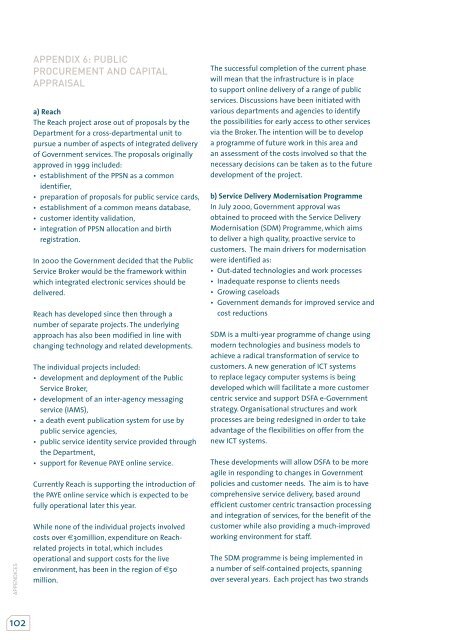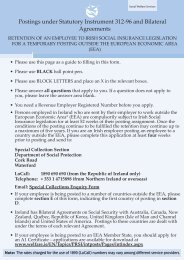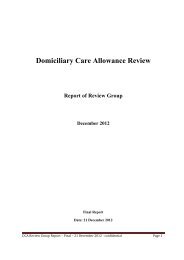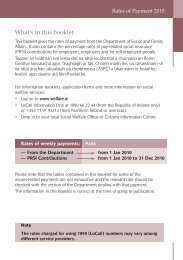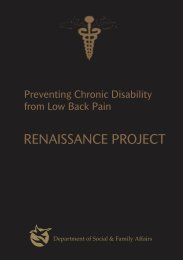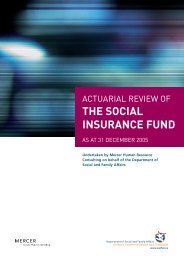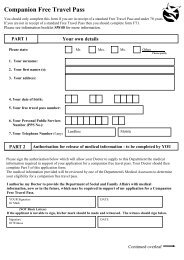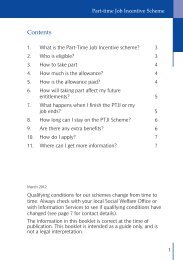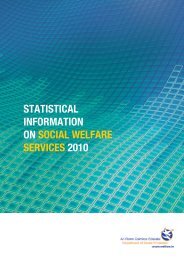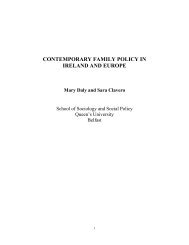department of social and family affairs annual report 2006 - Welfare.ie
department of social and family affairs annual report 2006 - Welfare.ie
department of social and family affairs annual report 2006 - Welfare.ie
Create successful ePaper yourself
Turn your PDF publications into a flip-book with our unique Google optimized e-Paper software.
appendices<br />
APPENDIX 6: PUBLIC<br />
PROCUREMENT AND CAPITAL<br />
APPRAISAL<br />
a) Reach<br />
The Reach project arose out <strong>of</strong> proposals by the<br />
Department for a cross-<strong>department</strong>al unit to<br />
pursue a number <strong>of</strong> aspects <strong>of</strong> integrated delivery<br />
<strong>of</strong> Government services. The proposals originally<br />
approved in 1999 included:<br />
• establishment <strong>of</strong> the PPSN as a common<br />
identif<strong>ie</strong>r,<br />
• preparation <strong>of</strong> proposals for public service cards,<br />
• establishment <strong>of</strong> a common means database,<br />
• customer identity validation,<br />
• integration <strong>of</strong> PPSN allocation <strong>and</strong> birth<br />
registration.<br />
In 2000 the Government decided that the Public<br />
Service Broker would be the framework within<br />
which integrated electronic services should be<br />
delivered.<br />
Reach has developed since then through a<br />
number <strong>of</strong> separate projects. The underlying<br />
approach has also been modif<strong>ie</strong>d in line with<br />
changing technology <strong>and</strong> related developments.<br />
The individual projects included:<br />
• development <strong>and</strong> deployment <strong>of</strong> the Public<br />
Service Broker,<br />
• development <strong>of</strong> an inter-agency messaging<br />
service (IAMS),<br />
• a death event publication system for use by<br />
public service agenc<strong>ie</strong>s,<br />
• public service identity service provided through<br />
the Department,<br />
• support for Revenue PAYE online service.<br />
Currently Reach is supporting the introduction <strong>of</strong><br />
the PAYE online service which is expected to be<br />
fully operational later this year.<br />
While none <strong>of</strong> the individual projects involved<br />
costs over €30million, expenditure on Reachrelated<br />
projects in total, which includes<br />
operational <strong>and</strong> support costs for the live<br />
environment, has been in the region <strong>of</strong> €50<br />
million.<br />
The successful completion <strong>of</strong> the current phase<br />
will mean that the infrastructure is in place<br />
to support online delivery <strong>of</strong> a range <strong>of</strong> public<br />
services. Discussions have been initiated with<br />
various <strong>department</strong>s <strong>and</strong> agenc<strong>ie</strong>s to identify<br />
the possibilit<strong>ie</strong>s for early access to other services<br />
via the Broker. The intention will be to develop<br />
a programme <strong>of</strong> future work in this area <strong>and</strong><br />
an assessment <strong>of</strong> the costs involved so that the<br />
necessary decisions can be taken as to the future<br />
development <strong>of</strong> the project.<br />
b) Service Delivery Modernisation Programme<br />
In July 2000, Government approval was<br />
obtained to proceed with the Service Delivery<br />
Modernisation (SDM) Programme, which aims<br />
to deliver a high quality, proactive service to<br />
customers. The main drivers for modernisation<br />
were identif<strong>ie</strong>d as:<br />
• Out-dated technolog<strong>ie</strong>s <strong>and</strong> work processes<br />
• Inadequate response to cl<strong>ie</strong>nts needs<br />
• Growing caseloads<br />
• Government dem<strong>and</strong>s for improved service <strong>and</strong><br />
cost reductions<br />
SDM is a multi-year programme <strong>of</strong> change using<br />
modern technolog<strong>ie</strong>s <strong>and</strong> business models to<br />
ach<strong>ie</strong>ve a radical transformation <strong>of</strong> service to<br />
customers. A new generation <strong>of</strong> ICT systems<br />
to replace legacy computer systems is being<br />
developed which will facilitate a more customer<br />
centric service <strong>and</strong> support DSFA e-Government<br />
strategy. Organisational structures <strong>and</strong> work<br />
processes are being redesigned in order to take<br />
advantage <strong>of</strong> the flexibilit<strong>ie</strong>s on <strong>of</strong>fer from the<br />
new ICT systems.<br />
These developments will allow DSFA to be more<br />
agile in responding to changes in Government<br />
polic<strong>ie</strong>s <strong>and</strong> customer needs. The aim is to have<br />
comprehensive service delivery, based around<br />
effic<strong>ie</strong>nt customer centric transaction processing<br />
<strong>and</strong> integration <strong>of</strong> services, for the benefit <strong>of</strong> the<br />
customer while also providing a much-improved<br />
working environment for staff.<br />
The SDM programme is being implemented in<br />
a number <strong>of</strong> self-contained projects, spanning<br />
over several years. Each project has two str<strong>and</strong>s<br />
102


